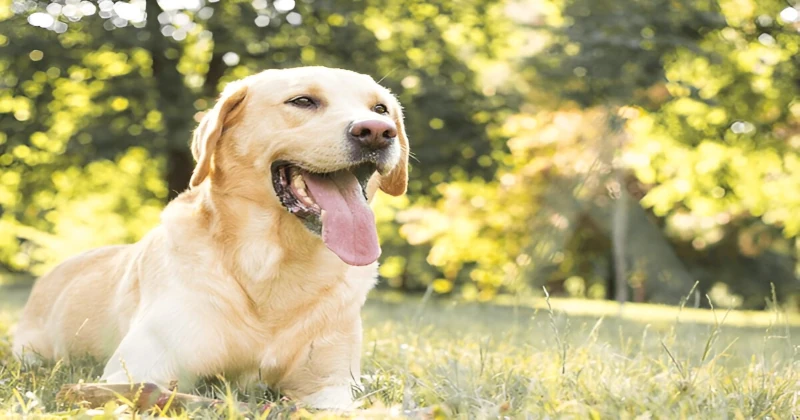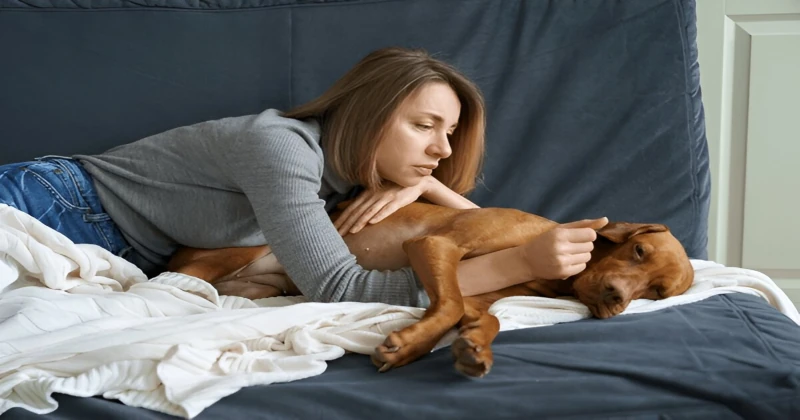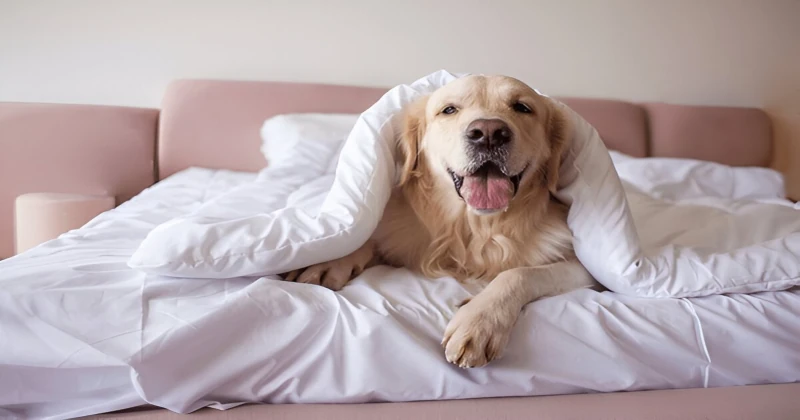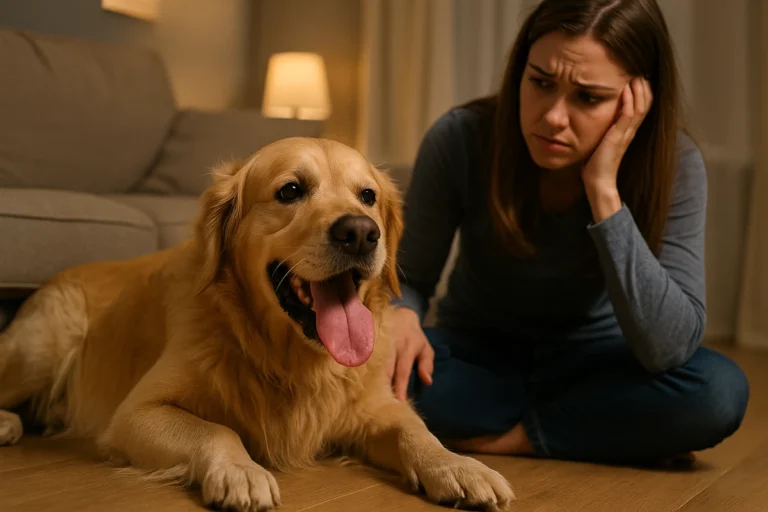Table of Contents
Introduction
It’s 3 a.m., the house is dark, and suddenly you hear your pup huff-huff-huffing beside the bed. Sound familiar? Occasional panting in dogs is perfectly normal—they don’t sweat the way we do, so quick, open-mouthed breathing is how they release heat. But persistent nighttime panting (also searched as dog panting while sleeping or dog breathing heavy at night) can be a red flag, signaling anything from a stuffy bedroom to a serious health issue.
In this guide we’ll answer the big question—“why is my dog panting at night?”—by breaking down:
- What’s normal versus abnormal panting
- The most common causes (environmental, emotional, and medical)
- When it’s time to call your veterinarian
- Simple home fixes and long-term prevention tips
By the end you’ll know how to spot trouble early, keep your dog comfortable, and—hopefully—get everyone in your household back to sleep.
Understanding Normal vs. Abnormal Panting

What Counts as “Normal” Panting?
- Cooling off
Dogs pant to lower body temperature when it’s hot or humid. A little post-walk huffing or a few minutes of panting after play is expected and should taper off quickly once they rest and cool down. - Excitement & mild stress
Greeting you at the door, meeting new people, or brief nervous moments (like stepping into the vet’s lobby) can all trigger short-lived panting
Signs Panting Could Be Abnormal—Especially at Night
Red-Flag Pattern | What It Might Mean | Why It Matters |
Panting continues more than 10–15 minutes after exercise or in a cool room | Overheating, pain, anxiety | Dogs should cool down quickly once the trigger is gone |
Heavy panting while completely at rest or asleep | Heart or lung disease, hormonal disorders (e.g., Cushing’s) | These conditions often worsen when the dog lies flat |
Accompanied by pacing, whining, or clinginess | Separation anxiety, noise phobia | Emotional stress keeps the brain on high alert, spiking breathing rate |
Pale/blue gums, coughing, or collapse | Oxygen shortage, heatstroke, or heart failure | This is an emergency—seek veterinary care immediately |
A quick pant isn’t cause for panic, but repeated or intense panting at night—when the environment is cool and calm—deserves your attention. By noting when it happens and what else you observe (e.g., restlessness, gum color, room temperature).
Common Causes of Nighttime Panting

Understanding why is my dog panting at night begins with pinpointing the root cause. Below are the most frequent culprits and what you can do about each one.
Environmental Factors
Trigger | Why It Happens | Quick Fixes |
Heat & Humidity | Dogs off-load heat by panting; a stuffy bedroom or thick bedding traps warmth. | Lower the thermostat to 68–72 °F, switch to a breathable bed, add a fan, or try a canine cooling mat. |
Poor Ventilation | Stale air and carbon dioxide buildup make breathing harder. | Crack a window, run an air purifier, or move the dog’s bed away from tight corners. |
Pro Tip: If you live in a hot, humid climate, give your dog’s water bowl a nighttime ice cube refill—small, safe, and surprisingly effective.
Anxiety and Stress
- Separation Anxiety:
Some dogs fret when you leave the room, leading to pacing and panting.
Solution: Start a “good-night” routine—calm walk, brief cuddle, then a long-lasting treat or chew to create positive associations with bedtime. - Noise Phobias:
Thunderstorms, fireworks, or even a neighbor’s late-night car alarm can spike cortisol.
Solution: Use white-noise machines, sound-dampening curtains, or thunder shirts. Pair these with desensitization training during daylight hours. - Changes in Routine:
A new work schedule, houseguest, or move can tip a sensitive dog into nighttime restlessness.
Solution: Re-establish predictable mealtimes, potty breaks, and lights-out. Consistency is calming.
Medical Conditions
Condition | Hallmark Signs Beyond Panting | What to Do |
Pain / Discomfort (arthritis, injury) | Limping, reluctance to jump, licking joints | Ask your vet about NSAIDs, joint supplements, and orthopedic beds. |
Heart Disease | Coughing, exercise intolerance, bluish gums | Schedule a cardiac exam and chest X-ray; early meds can slow progression. |
Respiratory Disorders (laryngeal paralysis, collapsing trachea) | Loud raspy breathing, voice change | Weight control, harness instead of collar, possible surgical options. |
Cushing’s Disease | Pot-belly shape, hair loss, constant thirst | Bloodwork and ultrasound confirm; daily medication manages cortisol. |
Anemia | Lethargy, pale inner eyelids, rapid heartbeat | Identify the cause (bleeding, parasites, immune issues); treat promptly. |
Age-Related Factors
- Cognitive Dysfunction Syndrome (Canine Dementia):
Older dogs may pant, pace, or stare at walls after sunset.
Management: Keep lights dim (not dark), offer brain-boosting games early in the day, and discuss cognitive decline medications (selegiline, SAM-e) with your vet.
Medication Side Effects
Common culprits include prednisone, dexamethasone, and some thyroid drugs, all of which can trigger excessive panting in dogs. If your pup started panting soon after a new prescription, call your veterinarian to discuss dosage adjustments or alternatives.
When to Consult a Veterinarian

Most dogs who pant for a few minutes, cool off, and settle back to sleep are fine. Call your vet right away if you notice any of the following:
Emergency Red Flags | Possible Meaning |
Panting plus a swollen, drum-tight abdomen | Bloat (gastric dilatation-volvulus) — life-threatening |
Pale, blue, or gray gums | Oxygen deprivation, shock, severe anemia |
Collapse, severe weakness, or inability to stand | Heart failure, heatstroke, internal bleeding |
Non-stop panting for over 30 minutes in a cool room | Respiratory crisis, extreme pain |
Diagnostic Tests Your Vet May Recommend
- Physical Exam & History – temperature, heart/lung sounds, pain assessment
- Blood Panel – checks for infection, anemia, hormone imbalance
- Chest X-ray or Ultrasound – evaluates heart size, lung health, abdominal organs
- Joint X-rays – if arthritis or injury is suspected
- Cortisol Testing – screens for Cushing’s disease
Bottom line: If you’re asking yourself “why is my dog panting at night—and does this warrant a vet visit?” trust your gut. You know your dog best, and early intervention is always safer (and often cheaper) than waiting until symptoms snowball. Armed with the information above, you can act quickly, give your veterinarian clear details, and get your pup back to peaceful, quiet snoozing.
Home Remedies and Management

Not every case of dog panting at night demands an emergency dash to the vet. For many pups, simple environmental tweaks and calming techniques make all the difference.
| Goal | Action Steps | How It Helps |
| Cool the Sleeping Area | • Set the thermostat to 68–72 °F • Add a circulating fan or AC vent booster • Swap fluffy blankets for a breathable cotton sheet | Keeps core temperature down so your dog doesn’t need to off-load heat by panting. |
| Upgrade the Bed | • Orthopedic or memory-foam mattress • Elevated cot for airflow • Cooling gel pad insert | Relieves joint pain and improves airflow under the body. |
| Establish a Bedtime Routine | • Last potty break 30 min before lights-out • Five-minute “wind-down” cuddle or gentle massage • Give a long-lasting chew or food-stuffed toy in their crate/bed | Predictability lowers cortisol, easing nighttime anxiety and the heavy breathing that comes with it. |
| Try Calming Aids | • Plug-in Adaptil ® pheromone diffuser • White-noise machine • ThunderShirt ® or other compression wrap • Vet-approved CBD or L-theanine chews | Reduces stress responses—handy for dogs that breathe fast at night during storms or fireworks. |
| Optimize Evening Exercise & Feeding | • 30–45 min of moderate activity a few hours before bed • Feed dinner at least two hours before lights-out • Split meals for dogs prone to bloat | Helps burn nervous energy, aids digestion, and promotes deeper, calmer sleep. |
Tip for hot regions: Freeze a shallow bowl of low-sodium broth into an “ice lick.” It hydrates and cools without causing a middle-of-the-night potty break.
Preventative Measures

Keeping a log of dog heavy breathing at night episodes can reveal patterns you might otherwise miss—and give your vet invaluable data.
Regular Veterinary Check-Ups
- Bi-annual wellness exams for dogs over age seven; annual for younger pups.
- Ask about baseline bloodwork to flag early heart, lung, or hormonal issues.
- Keep vaccines, parasite prevention, and dental care up to date; systemic infections and tooth pain can trigger restless nights.
Behavior & Environment Tracking
- Journal it: Date, time, room temperature, recent foods/meds, and what else was happening (thunderstorm, houseguest, etc.).
- Smart collars and pet cams can record heart rate and nighttime activity, turning vague worries into concrete data.
Early Socialization & Training
- Puppy classes teach confidence, lowering the risk of adult anxiety disorders that show up as dog breathing fast at night.
- For rescues, gradual exposure to household noises and alone-time exercises build resilience.
Weight Management & Fitness
- Extra pounds put strain on the heart, lungs, and joints—common triggers for nocturnal panting.
- Aim for a body-condition score of 4–5/9; your vet can show you how to check ribs and waistline.
Conclusion
If you’ve ever Googled “why is my dog panting at night” you know how alarming that heavy midnight breathing can feel. Thankfully, most causes—from a warm bedroom to mild separation anxiety—are fixable with thoughtful tweaks to your dog’s environment and routine.
That said, don’t ignore persistent or worsening symptoms. Heavy or noisy panting paired with pale gums, bloating, coughing, or collapse warrants immediate veterinary care. Early diagnosis of heart disease, Cushing’s, or airway disorders can add years of comfortable sleep to your dog’s life—and yours.
Next steps for concerned pet parents in the U.S.
- Do a quick bedroom audit tonight—check temperature, airflow, and bedding.
- Start a 7-day panting journal to capture when, where, and how often episodes occur.
- Schedule a wellness exam if panting lasts more than a week despite your tweaks, or if any red-flag signs appear.
Your pup deserves peaceful nights, and with the right mix of observation, preventative care, and professional guidance, you can turn those late-night huffs into silent, happy snores.
Read more –
Best Home Remedies for Dog Scooting That Actually Work
Must-Know Signs Your Dog Needs to Be Neutered Soon
FAQs
Why does my dog pant more at night than during the day?
Dogs often pant at night because the bedroom is too warm, they feel anxious when separated from you, or hidden pain flares when they lie still. If the room is cool and panting continues, schedule a vet check.
Can certain breeds be more prone to nighttime panting?
Yes. Brachycephalic breeds (Bulldogs, Pugs), heavy-coated giants (Great Pyrenees), and heavier-bodied or aging dogs struggle to breathe efficiently and may pant heavily after lights-out. Keeping them cool and fit reduces the risk.
Is nighttime panting a sign of a serious health issue?
It can be. Persistent heavy breathing at night may signal heart disease, respiratory disorders, Cushing’s disease, or bloat. Call your veterinarian immediately if panting is loud, prolonged, or paired with pale gums, coughing, or collapse.
How can I differentiate between normal and abnormal panting?
Normal panting stops within 10 minutes in a cool room, and the dog appears relaxed. Abnormal panting is noisy, lasts longer, or comes with restlessness, drooling, or gum color changes—clear signs you should consult your vet.
What immediate steps can I take to comfort my dog?
Move your dog to a cooler, well-ventilated space, offer fresh water, turn on a fan, and speak calmly. For anxious pups, add a pheromone diffuser or snug anxiety wrap. Seek veterinary help if breathing doesn’t ease quickly.


